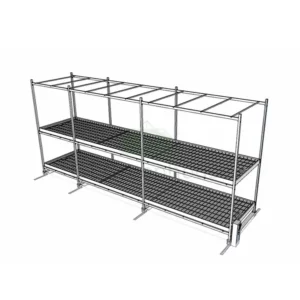Determining the appropriate flood and drain intervals for a grow rack system depends on several factors, including the specific needs of the plants being grown, the type of growing medium used, environmental conditions, and the stage of plant growth.
Here’s a step-by-step guide to help you determine the appropriate flood and drain intervals:
- Understand Plant Requirements: Different plant species have varying water and nutrient requirements. Research the specific needs of the plants you are growing, including their preferred moisture levels, root zone oxygenation requirements, and growth stage-specific watering needs.
- Assess Growing Medium: Consider the characteristics of the growing medium used in the grow rack system. Some growing media, such as coco coir or rockwool, hold moisture well but also require adequate drainage to prevent waterlogging. Others, like perlite or clay pellets, provide excellent aeration but may need more frequent irrigation.
- Monitor Root Zone Moisture Levels: Regularly monitor the moisture levels in the root zone of the plants. You can use a soil moisture meter or simply observe the moisture content of the growing medium. Aim to maintain a balance between keeping the roots moist without saturating them.
- Observe Plant Response: Pay attention to how the plants respond to different flood and drain intervals. Signs of overwatering include wilting, yellowing leaves, and stunted growth, while underwatering may lead to drooping leaves and soil dryness. Adjust the flood and drain intervals based on plant health and vigor.
- Consider Environmental Factors: Take into account environmental conditions such as temperature, humidity, and light intensity, as these factors can influence plant water uptake and evaporation rates. Hotter and drier conditions may require more frequent irrigation, while cooler and more humid conditions may necessitate less frequent watering.
- Start Conservatively: Begin with conservative flood and drain intervals and gradually adjust based on plant response and environmental conditions. Start with longer intervals between flooding sessions and shorter drain times, China Grow Racks supplier then fine-tune as needed to achieve optimal moisture levels.
- Monitor Runoff and Drainage: Observe the runoff and drainage during flood cycles to ensure that excess water is effectively removed from the growing medium. If drainage is insufficient, adjust the flood and drain intervals or improve the drainage system to prevent waterlogging.
- Consider Growth Stage: Tailor flood and drain intervals to the specific growth stage of the plants. For example, young seedlings may require more frequent irrigation to establish roots, while mature plants may need less frequent watering to prevent overwatering and root rot.
- Keep Records and Experiment: Keep detailed records of flood and drain intervals, plant responses, and environmental conditions. Experiment with different intervals and observe how plants perform under varying watering regimes. Use this data to refine your irrigation schedule over time.
- Seek Expert Advice: Consult with experienced growers, agronomists, or hydroponic specialists for personalized guidance and recommendations on determining the appropriate flood and drain intervals for your specific grow rack system and crops.
By systematically adjusting flood and drain intervals based on plant response, growing medium characteristics, and environmental factors, you can optimize water management and promote healthy plant growth in your grow rack system. Regular monitoring and adjustment are key to maintaining optimal moisture levels and maximizing crop productivity.
